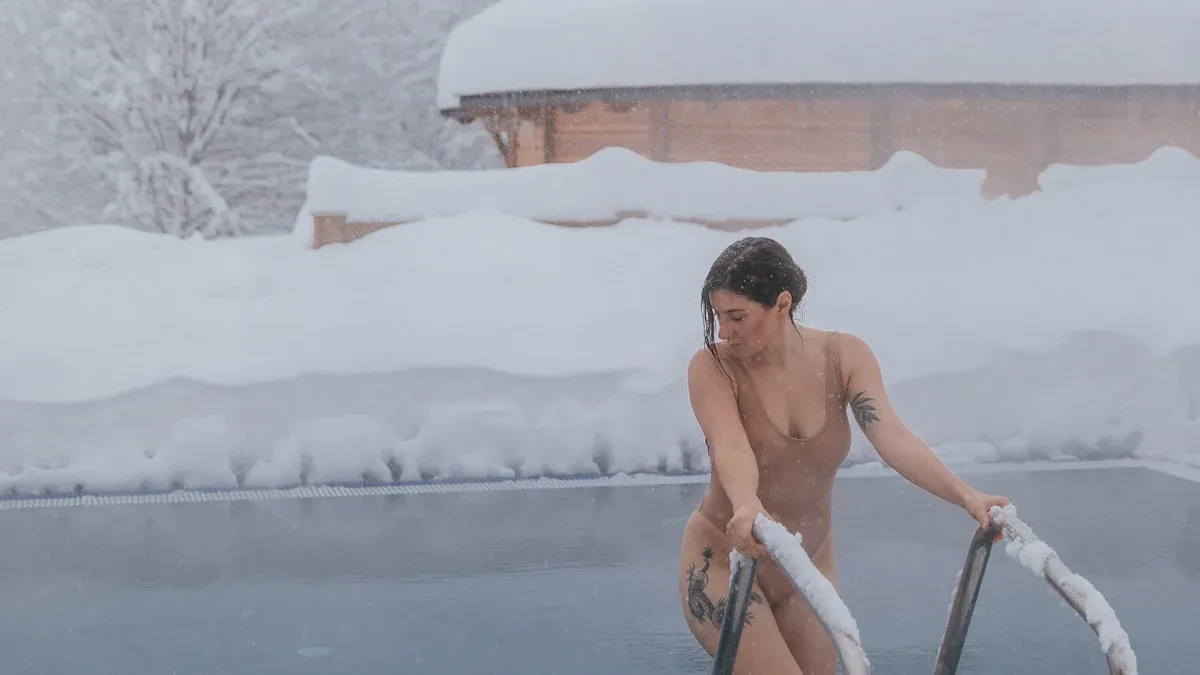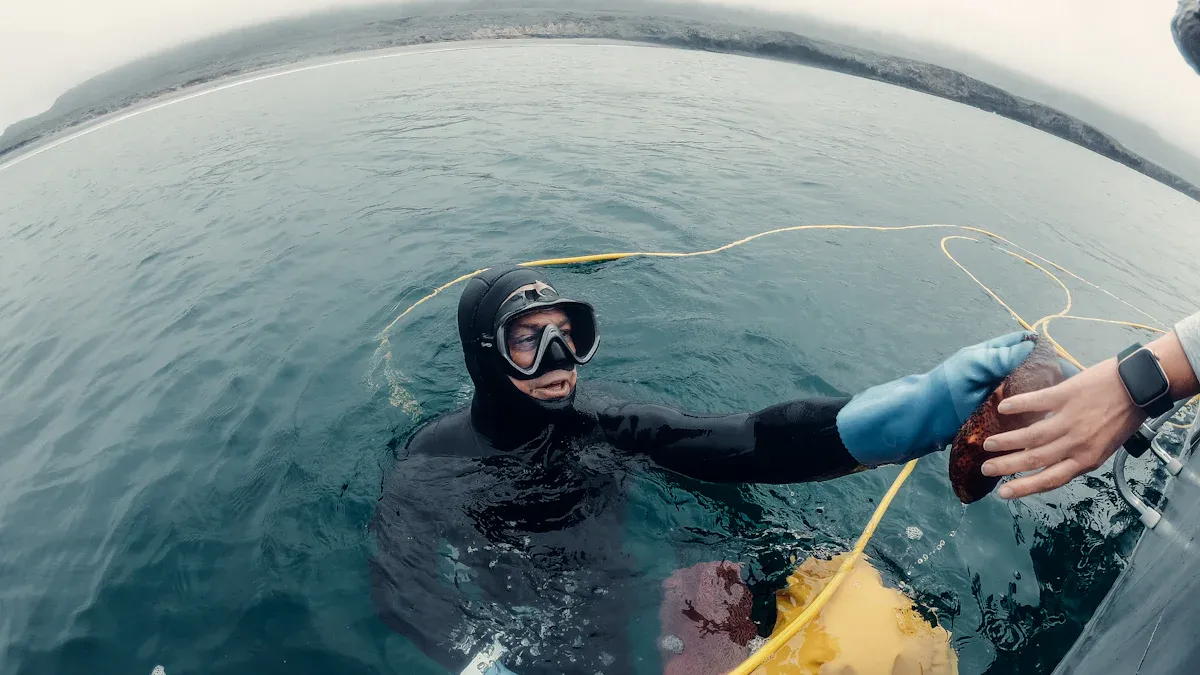
Have you ever felt the chill of cold water cutting your swim short? A thermal swimsuit might be just what you need. Unlike regular swimwear, it’s designed to keep you warm and comfortable in colder conditions. These suits use special materials to maintain your body temperature, helping you avoid hypothermia. They also offer extra buoyancy, making swimming easier and faster. Plus, many provide sun protection, shielding your skin from harmful UV rays. Brands like TideLine Swimwear specialize in these innovative designs, ensuring you stay cozy and safe in the water. If you're interested in expanding your options, consider learning how to source high-quality swimwear from China to find even more great choices.
Key Takeaways
Thermal swimsuits keep you warm by holding a thin water layer.
Your body heat warms this water, helping you stay cozy in cold water.
These suits help you float better, making swimming easier and faster.
They are great for both fun swimmers and serious athletes.
Choose a thermal swimsuit that fits your activity, like surfing or diving.
A good thermal suit lets you swim longer in cooler weather.
Make sure it fits well; a tight fit stops water leaks.
It keeps you warm and lets you move easily in the water.
What Are Thermal Swimsuits?
Definition and Purpose
A thermal swimsuit is a specialized type of swimwear designed to keep you warm in cold water. Unlike regular swimwear, it uses insulating materials to maintain your body temperature. This makes it ideal for swimming in chilly conditions or participating in water sports during cooler months. These suits also provide buoyancy, helping you stay afloat with less effort. Whether you're a casual swimmer or a triathlete, a thermal swimsuit ensures you stay comfortable and safe in the water.
How They Work
Thermal swimsuits work by trapping a thin layer of water between your body and the suit. This water warms up from your body heat, creating an insulating barrier against the cold. Most thermal swimsuits are made from neoprene, a synthetic rubber known for its excellent insulation. The thickness of neoprene varies depending on the suit's design. For example:
Thicker neoprene (4mm-5mm) is used in the legs to enhance buoyancy.
Thinner neoprene (2mm-3mm) is used in the upper body to allow greater flexibility.
Some suits also feature a thermal lining for extra warmth and an outer layer designed to resist abrasion. This combination of materials ensures you stay warm without sacrificing mobility.
Common Applications
Thermal swimsuits are versatile and cater to various activities. You can use them for open-water swimming, surfing, diving, or even paddleboarding. They're perfect for extending your swimming season into colder months. These suits also protect you from harmful UV rays, making them a great choice for sunny but cool days. If you enjoy water sports or outdoor swimming, a thermal swimsuit can be a game-changer.
Key Features of a Thermal Swimsuit

Insulating Materials
The materials in a thermal swimsuit are what make it stand out. Most of these suits use neoprene, a synthetic rubber that traps heat effectively. Neoprene has tiny air pockets that act as insulation, keeping you warm even in icy water. Some suits also combine neoprene with other fabrics like nylon or polyester for added durability and stretch. This blend ensures the suit stays snug while allowing you to move freely.
You’ll also find that the thickness of the material varies across the suit. Thicker sections provide warmth where you need it most, like your core, while thinner areas offer flexibility for your arms and legs. This balance makes a thermal swimsuit both functional and comfortable.
Heat Retention Technology
Thermal swimsuits don’t just rely on materials—they also use advanced heat retention technology. Many suits feature a thermal lining that reflects your body heat back to you. This lining feels soft against your skin and adds an extra layer of warmth.
Some designs include water-repellent coatings to minimize water absorption. Less water means less heat loss, so you stay warmer for longer. These features work together to create a suit that keeps you cozy without feeling bulky.
Design for Comfort and Functionality
A good thermal swimsuit isn’t just about warmth—it’s also about comfort. These suits are designed to fit snugly without restricting your movement. Flatlock stitching is often used to prevent chafing, so you can swim or surf without irritation.
Many suits also have zippers or adjustable closures to make them easy to put on and take off. Some even include reinforced panels in high-stress areas for added durability. Whether you’re swimming, diving, or paddleboarding, the thoughtful design ensures you can focus on enjoying your activity.
Benefits of Using a Thermal Swimsuit

Warmth in Cold Water
Have you ever hesitated to dive into cold water because of the chill? A thermal swimsuit can change that. These suits are designed to keep you warm by trapping a thin layer of water between your body and the suit. This layer warms up from your body heat, creating a barrier against the cold.
Thermal swimwear also uses materials like neoprene, which provides excellent insulation. This keeps your muscles at an optimal temperature, improving efficiency and reducing the risk of injuries. You’ll also notice increased buoyancy, which helps you swim faster and with less effort. Whether you're swimming in icy lakes or cool ocean waters, a thermal swimsuit ensures you stay comfortable and safe.
Extended Swimming Opportunities
If you love swimming but hate cutting your season short, a thermal swimsuit is a game-changer. These suits allow you to enjoy water activities even when temperatures drop. By trapping body heat and regulating your temperature, they make swimming in colder conditions not just possible but enjoyable.
The variable thickness of neoprene in these suits balances warmth and mobility. Thicker sections keep your core warm, while thinner areas let you move freely. This design means you can swim, surf, or paddleboard without feeling restricted. With a thermal swimsuit, you can extend your swimming season and explore colder waters with confidence.
Protection and Safety
Cold water can be dangerous, but a thermal swimsuit adds an extra layer of safety. By retaining body heat, it helps prevent cold-related injuries like hypothermia. These suits also protect your skin from harmful UV rays, making them ideal for sunny but chilly days.
The added buoyancy of thermal swimwear enhances your swimming speed and keeps you afloat more easily. This can be a lifesaver in challenging conditions. Whether you're a casual swimmer or an athlete, the safety features of a thermal swimsuit give you peace of mind in the water.
Versatility Across Activities
Thermal swimsuits aren’t just for one type of swimmer—they’re incredibly versatile and can adapt to a wide range of water activities. Whether you’re a casual swimmer or a competitive athlete, these suits have something to offer.
Here are some of the activities where thermal swimsuits truly shine:
Open-water swimming: If you love exploring lakes, rivers, or the ocean, a thermal swimsuit keeps you warm and comfortable. It helps regulate your body temperature, so you can swim longer without worrying about the cold.
Triathlons: Competing in a triathlon? These suits improve your performance by increasing buoyancy and reducing drag. You’ll glide through the water more efficiently, saving energy for the rest of the race.
Surfing and paddleboarding: Thermal swimsuits provide the flexibility you need to move freely while keeping you warm on windy or chilly days.
Diving and snorkeling: They protect you from cold water and offer UV protection, making them perfect for sunny yet cool underwater adventures.
Pro Tip: If you’re into multiple water sports, investing in a thermal swimsuit can save you from buying separate gear for each activity.
The design of these suits makes them ideal for both recreational and professional use. Their snug fit and advanced materials ensure you stay warm without feeling restricted. Plus, the added buoyancy and UV protection make them a practical choice for outdoor enthusiasts.
No matter what water activity you enjoy, a thermal swimsuit can help you make the most of it. You’ll stay warm, safe, and ready to take on new challenges, even in colder conditions.
Choosing the Right Thermal Swimsuit
Activity-Specific Needs
When picking a thermal swimsuit, think about how you’ll use it. Different water activities demand specific features. For example:
Surfing: You’ll need a suit with flexibility to handle constant paddling and movement.
Diving: Look for thicker material to keep you warm in deeper, colder waters.
Open-water swimming: A snug fit and streamlined design reduce drag and improve performance.
Durability is another key factor. Activities like surfing or diving can expose your suit to rough surfaces or sharp objects. Choose one with reinforced seams and high-quality materials to handle wear and tear. By matching your suit to your activity, you’ll stay comfortable and protected in the water.
Material and Thickness
The material and thickness of your thermal swimsuit play a big role in its performance. Most suits are made from neoprene, which provides excellent insulation. The thickness of neoprene, measured in millimeters, determines how warm or flexible the suit will be.
Thicker neoprene (4mm-5mm) offers better insulation, making it ideal for colder waters. However, it can limit your mobility. Thinner neoprene (2mm-3mm) allows for greater flexibility, which is perfect for warmer conditions or activities requiring a lot of movement. Finding the right balance between warmth and flexibility ensures you’ll perform your best, no matter the water temperature.
Fit and Sizing
A proper fit is essential for comfort and insulation. Your thermal swimsuit should feel snug but not restrictive. If it’s too loose, water can seep in, reducing its ability to keep you warm. On the other hand, a suit that’s too tight can limit your mobility and cause discomfort.
Pay attention to areas like the shoulders and knees. Loose fabric in these spots can create drag, while a suit that’s too small might make normal movements difficult. Always trust how the suit feels on your body. If it feels excessively tight or loose, try a different size. A well-fitted suit ensures you stay comfortable and efficient in the water.
Budget Considerations
When it comes to buying a thermal swimsuit, your budget plays a big role. You don’t have to break the bank to find a suit that works for you, but it’s important to know what you’re paying for. Let’s break it down so you can make a smart choice.
What Affects the Price?
Thermal swimsuits come in a range of prices, and several factors influence the cost:
Material Quality: Suits made with high-grade neoprene or advanced thermal linings tend to cost more. These materials provide better insulation and durability.
Thickness: Thicker suits often have a higher price tag because they offer more warmth and protection.
Brand Reputation: Well-known brands may charge more, but they often deliver reliable quality and performance.
Extra Features: Add-ons like UV protection, reinforced seams, or water-repellent coatings can increase the price.
Finding the Right Balance
You don’t always need the most expensive suit to meet your needs. Think about how often you’ll use it and in what conditions. If you’re a casual swimmer, a mid-range suit might be perfect. For frequent use or extreme conditions, investing in a premium option could save you money in the long run.
Pro Tip: Look for sales or discounts during off-seasons. You can often snag a high-quality suit at a fraction of the price.
Comparing Options
Here’s a quick comparison to help you decide:
Price Range | What You Get |
|---|---|
Budget ($50-$100) | Basic insulation, thinner material, fewer features. Great for occasional use. |
Mid-Range ($100-$200) | Good balance of warmth, flexibility, and durability. Ideal for regular swimmers. |
Premium ($200+) | Top-notch materials, advanced features, and maximum comfort. Best for extreme conditions or professional use. |
By understanding your needs and comparing options, you can find a thermal swimsuit that fits both your budget and your lifestyle.
Thermal swimsuits are a must-have if you love swimming in cooler conditions. They’re designed to keep you warm and comfortable, making every swim enjoyable. Experts agree that these suits:
Retain essential heat near your muscles, boosting propulsion and performance.
Provide increased buoyancy, helping you swim faster with less effort.
Whether you’re diving into icy waters or extending your swimming season, a thermal swimsuit is a smart investment. It’s your ticket to enjoying water activities all year long.
FAQ
What’s the difference between a thermal swimsuit and a wetsuit?
Thermal swimsuits focus on warmth and flexibility for swimming or light water activities. Wetsuits, on the other hand, are thicker and designed for extreme cold or high-impact sports like diving. If you’re swimming in moderate cold, a thermal swimsuit is your best bet.
Can I wear a thermal swimsuit in warm water?
Yes, you can! Thermal swimsuits regulate your body temperature, so they won’t overheat you in warm water. However, if the water is very warm, a regular swimsuit might feel more comfortable.
How do I care for my thermal swimsuit?
Rinse it with fresh water after every use to remove salt, chlorine, or dirt. Avoid wringing it out, and let it air dry in the shade. This keeps the materials intact and extends its lifespan.
Pro Tip: Use a wetsuit cleaner occasionally to keep it fresh and odor-free.
Are thermal swimsuits suitable for kids?
Absolutely! Thermal swimsuits are great for kids who swim in cooler water. They keep them warm and comfortable, so they can enjoy their time in the water longer. Just make sure to choose the right size for a snug fit.
Do thermal swimsuits improve swimming performance?
Yes, they can! The added buoyancy helps you float higher, reducing drag and making swimming easier. You’ll also feel more confident in cold water, which can boost your overall performance.
Fun Fact: Many triathletes use thermal swimwear to enhance their speed and endurance.
